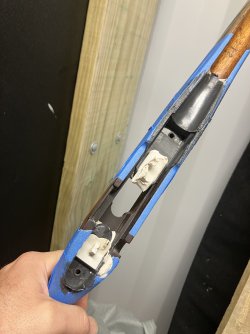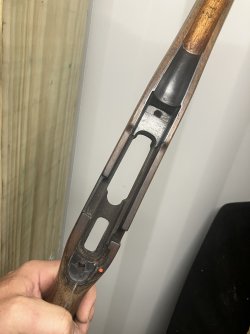First I would like to start out by saying that I do not own any Howa rifles, nor do I have any rifles with plastic stocks. With the exception of one rifle, all of my rifles are walnut and bluing. My answer to your first question about loads that were pet loads are no longer your pet loads and have to be tweaked. The answer, for me, is absolutely, the performance/accuracy has to change? When a rifle is bedded, the barrel harmonics are definitely going to change due to the pressure/s asserted by the stock has changed to different areas of the barrel. Resting the end of the barrel onto a rest or onto a tree limb to steady a shot will change POI. Put a piece of tape or apply some pressure between the end of the stock and the barrel and something is going to change the barrel harmonics and how that rifle shoots. Change the stock's pressure and its contact points, harmonics have to change. I have been bedding rifles to get better accuracy out of them for many years; 40+ or more! The rifles that I "do" glass bed are Remington 700s, but mostly Ruger 77s, many many 77s. My mentor who started me out glass bedding was a member of the U.S. Army rifle team from the Viet Nam era. He was quite astute on how to make just about any firearm shoot better. He once showed me how to make the M1 Garand shoot better with the cover from a book of matches while we were shooting in a match together. When I bed I start out with finding two original points of contact on the stock. For me with the Ruger 77s I chose to leave the tang area and a 1/8th wide strip of wood just in front of the magazine well intact and untouched to maintain the original position of the barrel within the barrel channel. These two areas never get touched and are maintained throughout the entire process. I then will mark off a 1/8 wide strip in front of the magazine well and then start relieving the wood from around the entire recoil lug area as well as at least 3/4 of an inch in front of the recoil lug to make room for bedding compound. From that point on I will relieve the wood with a 1/4 inch round gouge chisel, making grooves in the wood about 1/8th deep the entire length of he barrel channel. When I get to the end of the fore end I am careful not to remove too much wood, generally using a dowel wrapped with 180 paper to relieve the rest of the wood in that area. Once I am done making the grooves with gouge (1/2 round) chisel I will then mark the area where the barrel channel and the wood meet with the fine point of a felt tipped market onto the stock. Usually the mark will be about 1/16th to 1/8 wide mark. From this point I will use a Dremel tool with a course 1/2 inch sanding drum and remove that mark. Once this is done I will go back into the barrel channel and clean out the wood between the gouges that I placed with the gouging chisel so when completed I will have at least 1/16th to 1/8th inches of clearance between the barrel and the barrel channel. At this point I consider the stock ready to accept the bedding compound and totally prepped. I then go to the barreled action and mark off 4 inches in front of the recoil lug, this is the starting point where I will put two layers of .020 thousandths plumbers plastic tape from Brownells. I run the tape out so that it is at least 3-4 inches past the end of the fore end. From this point the metal is prepped with release agent and the entire barrel channel and the area between the recoil lug and the magazine well is filled with bedding compound, the barreled action is placed into the relieved stock and I clamp the stock and action together with a large wood clamp, I do not use the screws because I want to maintain contact with the two areas that I chose to maintain the barrel location within the barrel channel. When the bedding compound has hardened I remove the barreled action and clean up the excess bedding material. When the bedding job is finished the entire recoil lug area is bedded back to the 1/8th inches in front of the magazine well and also bedded 4 inches in front of the recoil lug. From that 4 inches in front of the recoil lug the entire barrel channel is bedded with .040 thousandths clearance around the entire barrel. I do not and have not ever used tape on the recoil lug, front back sides or bottom. I suspect that I will get some push back on this, however this is what I have been doing and get good accuracy after my bedding job. When the bedding has been cured I will wait a week and then piller bed the rear action screw. With the Ruger 77s, once the recoil lug area has been clearanced around the recoil lug there really isn't enough wood left between the recoil lug and the bottom metal to allow for any movement. I hope all of this makes sense to everyone.My Howa Mini is a good fit in my B&C M40 stock, except a little bit forward and back slop.
I bedded the recoil lug with JB Weld and shot a load that's always been kinda average. There was a noticeable improvement in dispersion. Load went from 1.25 typical to 0.75 MOA. I was excited until I shot a pet load that's unexpectedly opened up.
Anyone have to tweak their loads after bedding? BTW the epoxy spread into front of the recoil lug. It doesn't extend beyond the chamber portion. I only taped off the bottom of the lug so it's now a tight fit.
View attachment 638907
Up to the present I have been using Brownell's Acra Glas, however over the years I believe that Brownell's has changed their epoxy formulas and I am finding it more and more difficult to get the epoxy to the consistency that I want to thicken the mixture. I have been using the ground fiberglas in the West System, but I am still having difficulty getting the epoxy to thicken to the point where it doesn't run. I am looking around for another bedding product for my next job. I'm thinking that DevCon is going to be the next product that I use for my next bedding job.
I know this is a long reply, however this is how I do all of my rifles. When I am done, what used to be a good load may get even bettor, or... no longer is it a good load and I have to start over. First thing that I notice is that the POI will change, oftentimes dramatically. Usually my ladder loads will be done in .5 grain increments. Sometimes the lowest load will be the best, and with some rifles the maximum load will work the best in that same rifle.
Last edited:


